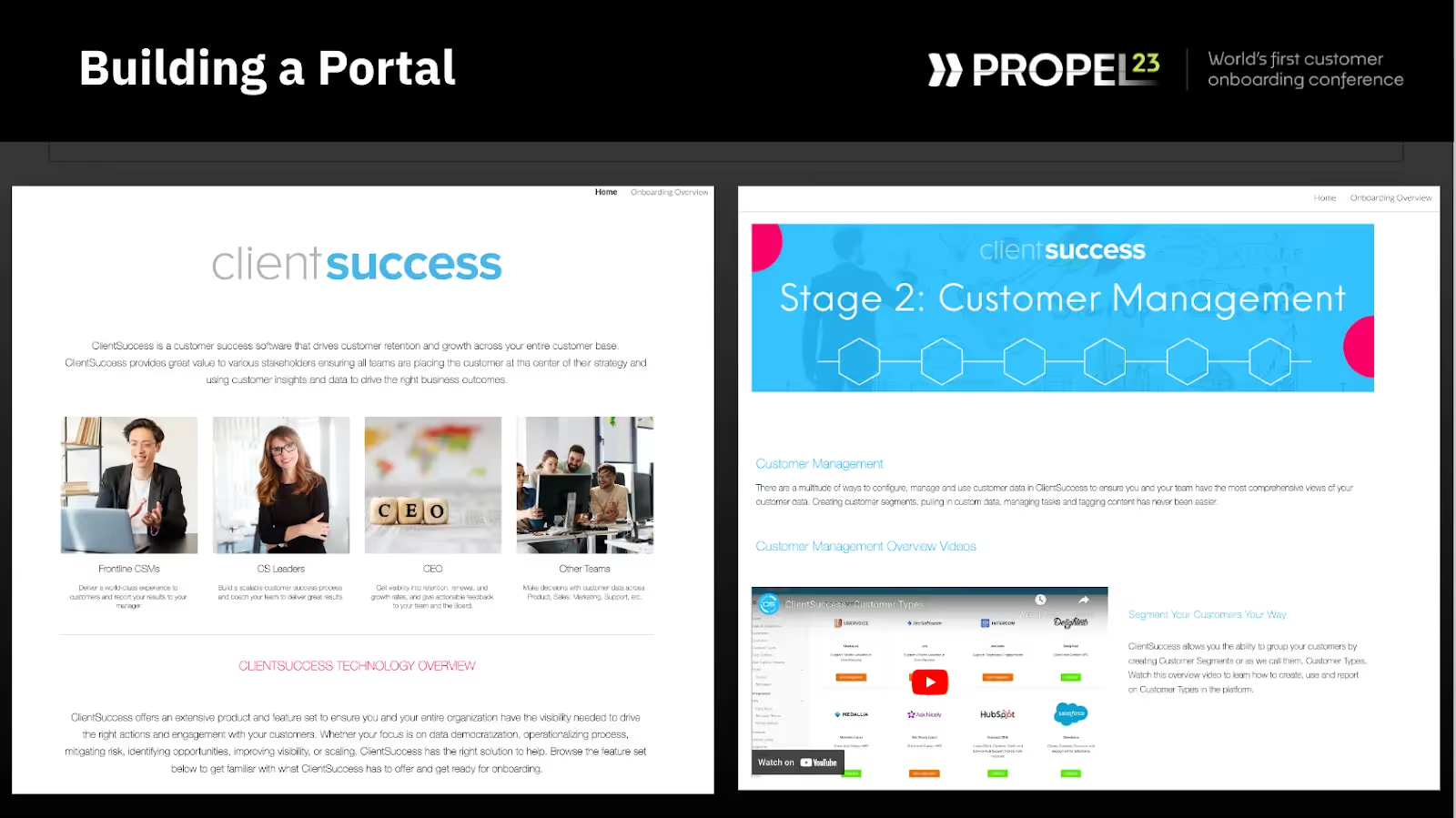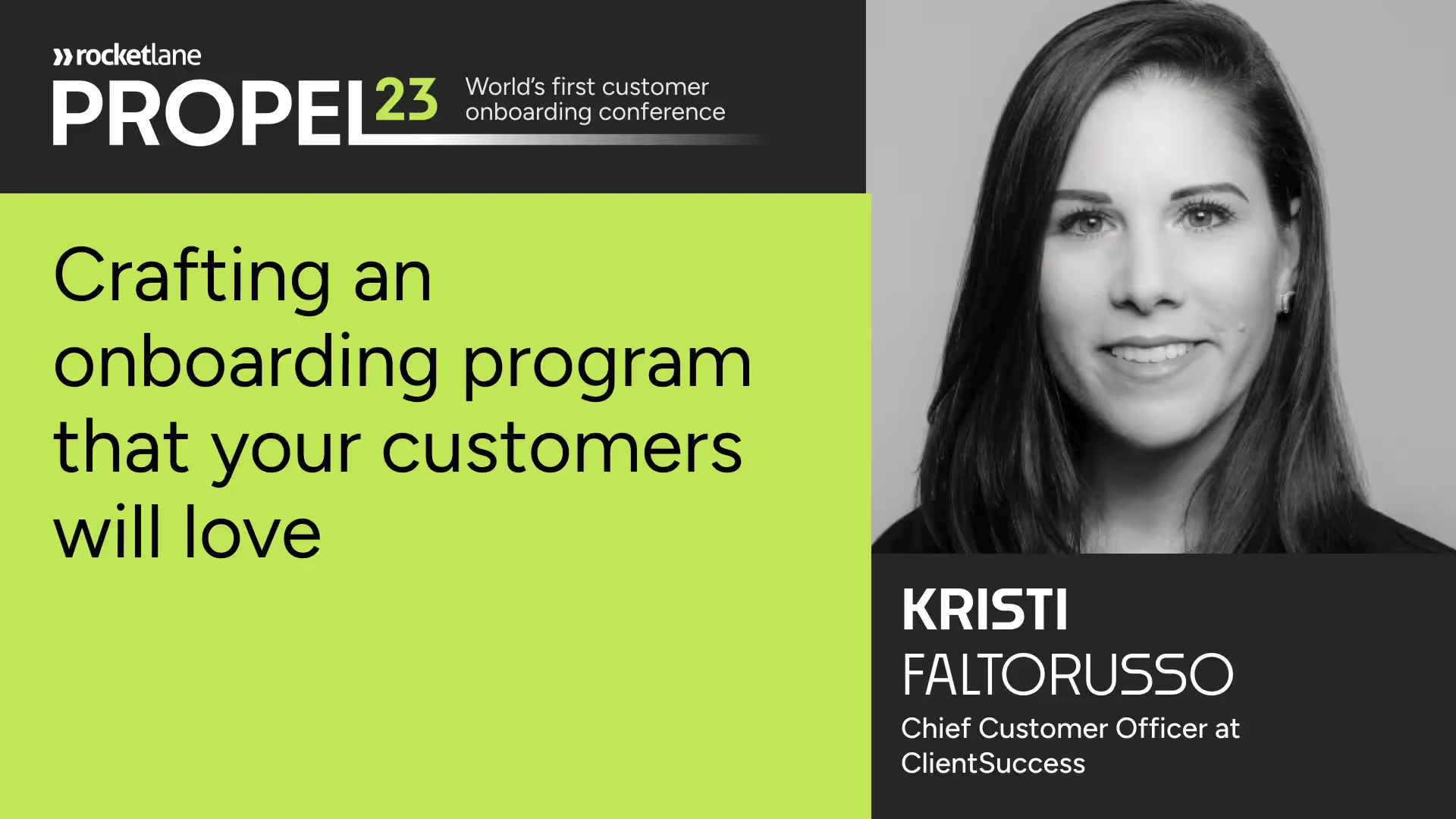Further reading
- Listen to Kristi Faltorusso talk about the Partnership Kickoff Model
- Check out what Katie Clark has to say about scaling the customer onboarding function at a hypergrowth startup
- Here’s a guide to perfecting the high-touch customer onboarding experience
Kristi Faltorusso is an award-winning Customer Success Executive with experience in building, scaling, and transforming Customer Success organizations at hyper-growth B2B SaaS companies. Over the past decade, she's helped many companies redefine Customer Success resulting in increased retention, long-term revenue growth, and customer advocacy.
At her workshop at Propel23, Kristi Faltorusso walked us through a framework to build an effective customer onboarding program with zero investment and zero resources. She discussed what customer onboarding is and its impact, the business of onboarding, the things to consider, and the steps involved in creating a customer onboarding program.
What is customer onboarding?
Customer onboarding refers to the process of assisting new customers in setting up and independently using your product to achieve their goals. As a SaaS company, the ultimate aim is for customers to effectively utilize the software as intended, enabling them to drive their goals. Therefore, it is crucial to focus on this aspect. Many onboarding programs tend to rush customers through the process. However, when reaching the end, customers often struggle to use the technology independently, integrate it into their workflows, and properly adopt it. The priority is developing a core competency to ensure customers can independently use the product.
The second important aspect of customer onboarding is helping customers achieve their goals. Often customer onboarding programs are designed in a checkbox-like manner, attempting to fit a one-size-fits-most approach. While such programs may assist customers with a few tasks, they may fall short in aligning the onboarding process with customers' specific objectives. This could involve investing significant time configuring product features that customers may not require or want to use since they do not align with their original purchase intentions. Consequently, when considering customer onboarding, it is vital to emphasize these two goals:
- Getting customers up and running independently
- Ensuring that the onboarding program guides them on a journey to achieve their desired outcomes
The importance of effective customer onboarding and the consequences of inadequate onboarding
The reality is that most customers will decide to churn even before the customer onboarding process is completed. If you provide a poor onboarding experience or implement an ineffective program, it guarantees losing customers. They will struggle to adopt and utilize the product, indicating they are not deriving value from it. Inevitably, your product will become shelfware.
Attempting to reboard customers and generate value later in their journey can be challenging. By that point, the momentum and excitement would have been lost, and the partnership will falter. It's crucial to align understanding and recognize that customer onboarding significantly impacts the long-term success of the partnership. There is an opportunity here to get it right or wrong, and ensuring that upfront investments yield long-term success for the partnership is paramount.
The business aspect of customer onboarding
We all aim to solve business problems with technology and help our customers do things differently, improve efficiency, achieve a better ROI, and leverage technology effectively. Ultimately, our customers evaluate whether onboarding will help them achieve these outcomes. A successful onboarding program leads to higher customer retention rates, improved customer health scores, better Net Promoter Scores (NPS), and greater lifetime value. These are tangible business metrics that demonstrate the value of focusing on onboarding. If you need to articulate the importance of onboarding within your organization, these metrics provide a compelling case.
Surveys indicate that 63% of customers consider onboarding a key factor in their decision to subscribe to a product. Many prospects are eager to understand the customer onboarding process. Interestingly, their focus often revolves around the onboarding experience rather than the product's ability to drive ROI or achieve goals. They understand that success can be achieved together if both parties invest in onboarding.
Additionally, 74% of potential customers will switch to alternative solutions if the onboarding process is too complicated. This statistic highlights the risk of designing an onboarding program that overwhelms customers. If the experience is overly complex, customers may feel it requires too much effort and decide it's not worth it. This emphasizes the importance of simplifying the onboarding journey and making it engaging and exciting for customers, helping them reach their goals. These elements often receive less attention but significantly impact the long-term success of customer onboarding.
Kristi then walked us through how her team at Client Success transformed their onboarding experience from a complicated checklist to a streamlined and simplified process that their customers can easily follow.
Defining the goals of your customer onboarding program
In conversations with Customer Success professionals about their customer onboarding programs, Kristi often asks about their goals. Surprisingly, she found that many professionals have not considered defining a clear goal for customer onboarding. Their focus tends to be on getting customers onboarded quickly and achieving fast time-to-value, but they haven't considered the specific objectives they want to accomplish. Establishing a clear SMART goal tied to the customer onboarding process is essential to address this.
In Kristi’s role at Client Success, the objective was to redefine the onboarding program and identify what should be achieved with customers and how it will be measured. The first primary objective was to reduce the onboarding time significantly. Secondly, the customer onboarding program needed to prioritize core areas that led to faster value realization and ensure customers received thorough training and guidance on effective utilization.
With these objectives in mind, Kristi created an eight-week program, providing ample time for enabling customers, configuring the product, conducting training, and wrapping up the onboarding process. This achievable timeframe allowed for reconsidering content to align with the desired outcomes. Customers prioritize certain aspects based on their specific needs. While the focus remains on the five core areas, customers can deprioritize certain elements and emphasize others. Modular customer onboarding modules are in place, making it simple to customize the experience while maintaining a structured approach.
Furthermore, there was significant emphasis on training and enablement. Instead of relying solely on administrators to train end users, which can be challenging within an eight-week timeframe, the responsibility for end-user training is taken on by the customer onboarding team. The goal is to ensure that customers can independently use the product as intended to achieve their goals.
Having a clear goal lets the team stay focused on what they aim to achieve with the onboarding program. If the process extends beyond eight weeks, something may not go according to plan. It prompts conversations, assessment of shifting priorities, and ensures effective meeting of customers' needs. This goal-oriented approach helps the team identify whether things are going well or if adjustments are necessary.
Therefore, if a goal for the customer onboarding program hasn't already been defined, make it a priority to do so. The goal should be measurable and aligned with the objectives. This exercise will provide clarity and serve as a guiding force in the customer onboarding efforts.
Things to consider while crafting your customer onboarding program
When reevaluating your customer onboarding program, there are several factors you need to consider. They are:
- Product complexity: Is your product highly configurable or customizable? Understanding the complexity will help you tailor your customer onboarding process. For example, the onboarding requirements will differ for a product as complex as Salesforce from one simple as Calendly.
- Customization: Determine whether the onboarding process should be the same for all customers or if there are variables to consider. Do different customers purchase different products or packages? If so, you may need to create modular onboarding components to accommodate these variations.
- Resource allocation: Evaluate the resources needed to execute the onboarding process effectively. Depending on the nature of your product, you might require specific roles or expertise. For instance, if your product is highly technical, you may need BI solutions engineers or API specialists to assist with the implementation. Consider whether your customer success managers (CSMs) are equipped to handle the onboarding or if additional resources are necessary.
- Customer profiles: Consider the profiles of the customers you will be onboarding. Different customers will have varying levels of technical aptitude and familiarity with your product. Adapting your onboarding approach and materials to meet their needs is crucial for a successful onboarding experience.
- Collaboration tools: Consider whether you have software or collaboration platforms to facilitate effective communication and visibility throughout the onboarding process. Utilizing customer success management platforms or free tools like Excel or Google Sheets can help both parties stay aligned and track progress.
- Training and enablement: Evaluate the resources required for training and enablement during the customer onboarding process. Assess the existing content, such as articles, videos, webinars, and blog posts, and determine if it adequately supports customer onboarding. Identify any gaps and opportunities for creating additional content to enhance the customer onboarding experience.
Important metrics for a customer onboarding program
If we cannot track the success metrics of a customer onboarding program, assessing its effectiveness and making data-driven decisions would be challenging. Measurement allows us to track progress, identify areas of improvement, and ensure that the program is aligned with its intended goals. Here are the key metrics that Kristi recommends to measure the success of a customer onboarding program:
- Customer onboarding duration: Tracking the number of days customers take to complete the onboarding process provides insights into their engagement, participation, and prioritization level. If customers exceed the expected onboarding duration, it can indicate potential roadblocks or changes in their priorities.
- Usage, adoption, users, and logins: It is crucial to monitor how customers use the product and their adoption rates. It shows whether they are actively configuring and utilizing the platform. Lack of usage or adoption could indicate a problem with customer onboarding or a failure to launch effectively.
- Consumption: Depending on the nature of your product, measuring consumption metrics can be important. This could involve tracking factors like cloud storage space usage or other resources that customers consume. Understanding consumption patterns helps evaluate the value customers are deriving from the solution.
- Integrations: Consider the number of integrations your product has and how it is used with other systems or platforms. The more integrated your product is, the stickier it becomes, leading to increased usage and reach.
Designing the customer onboarding process
Kristi mentioned several important steps in designing an effective onboarding process to ensure a smooth and successful customer journey. They are:
- Work break-up: Break down all the tasks that need to be completed by customer and team. This will create a clear understanding of the work involved and who was responsible for each task.
- Work sequencing: Organize the tasks into sequences to determine the order in which they must be completed. This will help identify dependencies and allow for bundling related tasks together. It requires iterative adjustments to optimize the workflow.
- Collating digital assets: The available digital assets, such as knowledge base articles, blog posts, webinars, training videos, etc., should be reviewed and selected to support customers during onboarding. These resources should be gathered and evaluated to provide valuable assistance throughout the process.
- Defining milestones: Instead of merely focusing on checking off tasks, the customer onboarding process should be designed with milestones representing significant customer achievements. These milestones will highlight the tangible impact and new value customers could achieve by completing each stage.
- Defining success metrics: Key metrics should be defined to track the success and progress of the customer onboarding process. These metrics include integration, usage, product adoption, consumption, and onboarding duration. They will provide insights into customer engagement, product utilization, and potential roadblocks.
- Testing and iteration: The customer onboarding program should be tested iteratively with selected customers invited to participate in the beta testing phase. Customer feedback can be used to refine and improve the customer onboarding process. The iterative approach will optimize the program based on real customer experiences and needs.
An ideal customer onboarding flow
Kristi then showcased a customer onboarding program that received positive customer feedback. Here's a high-level overview of the flow of the customer onboarding program:
- Sales to Customer Success handoff: The transition from the sales team to the customer success team is streamlined to ensure a smooth transfer of information and enable the customer success team to support customers effectively. Efforts are made to automate data transfer from the CRM to empower the customer success team and minimize the time spent with the sales team.
- Welcome email: A welcome email is sent to all customers, introducing them to the onboarding process and setting the stage for their journey. It provides essential information and sets the tone for a positive onboarding experience.
- Customer survey: Customers are sent a survey to gather information about their needs, preferences, and expectations. This survey helps tailor the onboarding program to their specific requirements and ensures personalized support. It serves as a way to verify and align the information gathered during the sales process.
- Product setup: This stage focuses on configuring the customer's product tenant. It involves technical setup and ensuring that the product is ready for use. No design work is involved at this stage; it primarily aims to get the product set up and functional.
- Product configuration: In this stage, collaborative sessions are conducted between the customer and the customer success team. The focus is on building and training, working closely with customers to configure the product according to their needs. It involves hands-on guidance and knowledge sharing.
- Check-in with customers: Automated email check-ins are sent to customers who are in the onboarding process, usually around 45 days in. This proactive communication allows the customer success team to assess progress, address concerns, and schedule dedicated calls to discuss the onboarding experience and provide further assistance.
- Product training: Extensive product training is provided to both administrators and end-users. This training ensures customers understand the product's features, capabilities, and best practices for effective utilization.
- End-user training: As part of product training, specific sessions are dedicated to end-user training. This ensures administrators and end-users have the necessary knowledge and skills to maximize the product's value.
- Post-onboarding wrap-up: A formal milestone is established to mark the conclusion of the customer onboarding process. This wrap-up meeting provides an opportunity to review and celebrate the achievements during onboarding, clarify the next steps, and set expectations for the ongoing journey with the customer.
- Feedback collection: Customers are given the opportunity to provide feedback on their onboarding experience through a survey. This feedback helps identify improvement areas, address missed expectations, and ensure customer satisfaction. It allows for continuous refinement and optimization of the customer onboarding program.
Achieving meaningful outcomes through a customer-centric approach to onboarding
It's interesting how companies often define the first value for their customers, assuming that completing a specific action means they are receiving value. With a customer onboarding process customized to each customer, we can enable them to do something they could not do on their own - producing reports for greater transparency or setting up customer health scores to assess their customer base with accuracy. We can ensure that our customers receive meaningful results from our onboarding process to make their partnership successful.
A unique customer portal experience
Kristi led the audience through the Client Success team's web-based customer onboarding process redesign. Google Sites and Canva were employed to make a portal providing information about the company, its technology, and the different customer onboarding stages. To ensure smooth sailing, they developed a three-part "Getting Started" checklist based on customer feedback, an onboarding timeline, and a partnership kickoff meeting. These are developed with a clear agenda, and the presentation deck is shared beforehand to encourage beneficial dialogue.
Customers can view brief videos and tutorials throughout the onboarding process to facilitate their learning and enable them to complete tasks before their next appointment. Trackers are utilized to monitor progress and reward noteworthy accomplishments. Furthermore, a resource guide has been established that encompasses boot camp videos, masterclass instruction, playbooks, and a platform design workbook. The workbook is beneficial in guiding customers through configuring different software elements while providing insight into best practices and illustrations.

Although building such resources takes time, the benefits and positive customer feedback make it worthwhile.
Use Rocketlane to streamline and optimize customer onboarding
If you are considering optimizing your customer onboarding program, consider Rocketlane. It includes every must-have feature to make the onboarding process as painless as possible! It’s the ultimate guide to onboard new customers. You can achieve quality project management workflows, insights into customer satisfaction trends, and lower time-to-value.
With Rocketlane, every customer can access their own portal with a dedicated domain. You can brand and customize this customer portal by adding your touch via logos or themes to ensure a distinct connection with your brand. Every customer gets magic links that take them to their portal so they can see what you have in store for them.
On this portal, you can take them through interactive walkthroughs of your onboarding plan, assign tasks and follow up on them, request approvals and feedback, and share updates.
Interested? Book a demo or sign up for Rocketlane’s 14-day free trial today!















